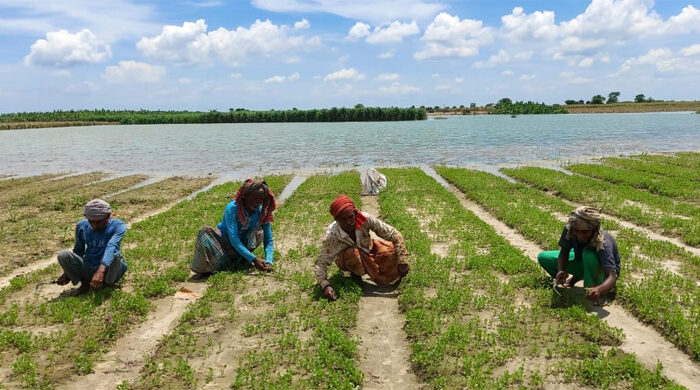
On the sprawling char lands of the Padma River in northern Pabna have been consistently producing high-quality coriander leaves. Thanks to good yields and effective marketing, farmers are earning nearly Tk. 50 lakh daily. Traders are collecting the coriander leaves directly from the farmers and supply it to district towns throughout the country. This business directly benefits farmers, as they are selling their products to buyers without the involvement of middlemen.
Though typically a winter crop, farmers have grown early coriander (pre-season) this year. While coriander seeds are used as a spice, fresh leaves are in high demand as these are essential ingredient in a variety of dishes.
Most of this coriander cultivation takes place in Ishwardi Upazila. According to the Ishwardi Upazila Agriculture Office, this year coriander leaves have been grown on 70 hectares of char land along the Padma River.
The office reports that daily sales from the chars amount to 1,100–1,400 maunds of coriander leaves, with a market value of Tk. 40 to 50 lakh. Thanks to their superior quality and aroma, these leaves meet local demand and are also shipped to Dhaka and other district towns. This crop has emerged as a vital source of income for local farmers and makes a significant contribution to the regional economy.
A recent field visits to the chars of Dadapur, Char Ruppur, Laxmikunda and Bilkedar shows extensive coriander cultivation. Farmers were seen busy harvesting and upkeep the crops, while traders handle post-buying processing—including packing, washing, cold storage with ice layers, and loading onto trucks.
According to the farmers, cultivating one bigha of coriander requires inputs such as fertilizer, irrigation, pesticides and marketing costs approximately Tk. 25,000 to Tk. 30,000. With a successful harvest, the same bigha can generate Tk. 80,000 Tk. 100,000. Traders from Chuadanga and other districts purchase coriander from Ishwardi chars.
One trader Almagir Hossain Bhuyian stated that they buy coriander at Tk. 40,000 Tk. 60,000 per bigha from local farmers. Farmers reports that in local markets, the price per kilogram ranges from Tk. 80 to Tk. 130.
Suitable Soil Conditions
According to local agriculture officials, Ishwardi’s char lands are well-suited for early coriander cultivation. The area features abundant sandy-loam or loamy soil, ideal for growing coriander leaves. Fields with proper drainage are especially favorable, as they support healthy yields. Situated along the river, these lands allow excess water to drain rapidly during rainfall, reducing the risk of crop damage.
Collection and Marketing Process
As no vehicle can move on vast char lands, after harvesting, coriander leaves are transported by bullock carts to the banks of the Padma River, then moved by boat to nearby areas for packaging. Once packed, the leaves are transported a short distance using engine-powered carts to different spots, where they are loaded onto trucks. These coriander leaves are then sent to Dhaka’s Kawran Bazar, Jatrabari, Cumilla, Barisal, Faridpur, Madaripur and other district towns.
Haurn Rashid, a trader from Jhenidah, explained that coriander cultivation is extensive in Jhenidah, Chuadanga and nearby districts like Meherpur. However, excessive rainfall this year damaged crops in those districts, while significant yields were obtained from Ishwardi’s chars such as Char Ruppur and Dadapur. They purchase the crops from local farmers, package it, and supply it to Dhaka and other cities.
Ishwardi Upazila Agriculture Officer Abdul Momin stated that due to the crop losses from excessive rain in nearby districts like Chuadanga, Jashore and Meherpur, the coriander from Ishwardi chars has gained increased importance
Although floods affected Ishwardi’s chars as well, the sandy soil and elevated riverbank location allowed water to drain quickly.
Jahangir Hassain, a farmer from Laxmikunda village, said that although some fields were damaged by flooding, the good overall yield prevented serious losses.
Agriculture officer Abdul Momin added that farmers are profiting from coriander cultivation. He noted that this early-season production continues until March–April of the following year.
Aman/